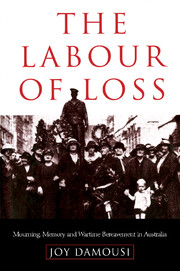6 - Absence as Loss on the Homefront and the Battlefront
Published online by Cambridge University Press: 06 July 2010
Summary
God how terrible is this leaving all I love.
When the Second World War broke out in September 1939, links between the two world wars were immediately made. The memories of the First World War re-entered inescapably into people's lives as they braced themselves for yet another conflict. Each year Anzac Day, the occasion of remembrance, provided a source of continuity with the past, for although those who participated in the Second World War shaped their own war stories, they drew irresistibly on earlier national mythologies. ‘For twentyfive years’, the Sydney Morning Herald noted in 1940, ‘we have kept a day of memory, a day from which to draw the inspiration of a splendid past.’
By the beginning of the next war, the meaning of that inspiration and memory had been rewritten and imagined in different ways. As the peace movement became more prominent, and isolationist voices emerged, there had been a shift in the meaning of war. But it remained central to nationalist mythologies. The instability of postwar peace created conditions which were to usher in a new war as unresolved hostilities created mounting antagonisms.
The enlistment of the next generation of sons revived emotions connected to an earlier time and place. The advent of another war could still arouse immediate sadness, for a mere twenty years had elapsed since the earlier conflict. One woman remembered that her older brother could not ‘wait to turn eighteen to enlist’, but ‘it saddened my father and mother, Dad having seen action in France in 1916–17 and carried the sadness with him, and Mum having lost a brother in France.’
- Type
- Chapter
- Information
- The Labour of LossMourning, Memory and Wartime Bereavement in Australia, pp. 105 - 125Publisher: Cambridge University PressPrint publication year: 1999

